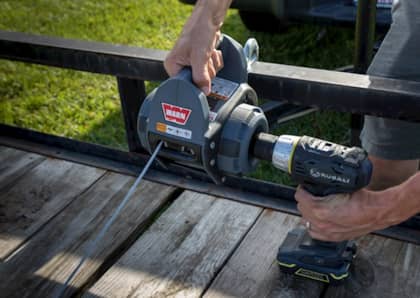Steel vs. Synthetic: Which Winch?
Imagine that your 4x4 slides off the trail, leaving you just feet from becoming a permanent mark on the landscape below. You have two options: One, get pulled up the cliff via a steel cable; or two, get pulled up by a synthetic rope. Which would you trust with your life?
While advancements in technology have made winches lighter, faster and stronger over the years, possibly the most controversial modern winch accessory is the move to synthetic rope. Compared to steel cable, synthetic rope is significantly lighter and much easier to handle. This has made it a major draw for professional tow-truck operators as well as recreational off-road enthusiasts.
Though synthetic rope has some clear advantages, it’s not universally embraced. In fact, there are plenty of people who argue the merits of both. To offer a better idea on which is best for your 4x4, we’ve put together a list of things to consider when determining which line is best.

Strength
In the automotive sector, you can purchase synthetic rope that is equal to (or sometimes stronger) than a given steel cable. The issue with synthetic cable failure is rarely due to the rope not being strong enough, but rather it breaking down due to sliding or rubbing against a harsh surface. Most synthetic ropes will come with a sleeve to allow the rope to pass through when draped over an obstacle, but you can be limited by the sleeves length or number of obstacles in the path. Given steel’s surface strength, it handles making contact with terra firma much better.
Weather Resistance
Heat and direct sunlight are two of synthetic rope’s biggest enemies. UV light can breakdown the fibers, ultimately fading the rope and making it brittle. Frequent ‘wheeling in mud and sandy soil can also harm the rope, so special care must be taken to wash out the cable after more serious outings. Rope can also hold water and freeze during the winter. Steel’s biggest nemesis is usually rust. While it’s less susceptible to damage from the elements, you’ll need to occasionally inspect the cable to ensure rust hasn’t compromised any of the strands. The occasional soaking of WD-40 can also go a long way with a steel cable.
Weight
Synthetic rope is significantly lighter than steel. This means it will be easier to free-spool and haul to your anchor point. Your 4x4 will also appreciate the reduced pounds to haul around. Without question, this is one area synthetic rope simply outshines the heavy cable. Note: Despite how light rope is, it’s still recommended to use proper gloves when handling either steel or cable.
Ease of Repair
There’s a common misconception that you can’t mend a broken steel cable on the trail. This is not true. It will however take the proper tools and knowhow to be done correctly. Synthetic rope on the other hand can be mended much easier. While mending rope or cable on the trail should only be done as a temporary fix, it’s something to consider.
Safety
If you’ve ever witnessed a winch cable or rope break under load, you know it happens in the blink of an eye. Both can kill you and it’s not something to take lightly. Everyone knows that a steel cable is deadly when it snaps at you at speed, but so is rope. Recovery dampers, such as the one offered from ARB, should be used whenever possible. Studies have shown that placing a winch weight in the center of the cable will generally result in the cable or rope simple falling to the ground versus snapping back in one direction or the other.
Cost
If you’ve looked at a new winch recently, you’ve likely noticed that ones with the synthetic rope are a bit more expensive than the ones with steel. If cost is a factor for you, this can likely lead you to sticking with the slightly more affordable steel setup. Keep in mind that you may have to replace the synthetic rope every few years depending on use and sun exposure.
So, which is better?

When it comes to the right line for you, we say it comes down to the owner. Are you the type of ‘wheeler that will be committed to preserving your rope? This means washing it thoroughly after off-road trips, and keeping it protected (covered) from the sun? There’s also the fact that synthetic rope starts to breakdown above 150 degrees. So, a hot drum and summer ‘wheeling can be tough on the fibers.
The major plus side is that it’s easier to handle and weighs less. This is one of the reasons we are seeing it used in many professional industries as the fatigue associated frequently hauling cable is greatly reduced. When it comes to failure rate, we’ve personally witnessed more synthetic ropes fail than steel cable, but that’s not to say one is better than the other. For simplicity and strength, we tend to gravitate towards steel. If you don’t mind the up keep and potentially shelling out for a new rope every few years, we say synthetic is the way to go.











